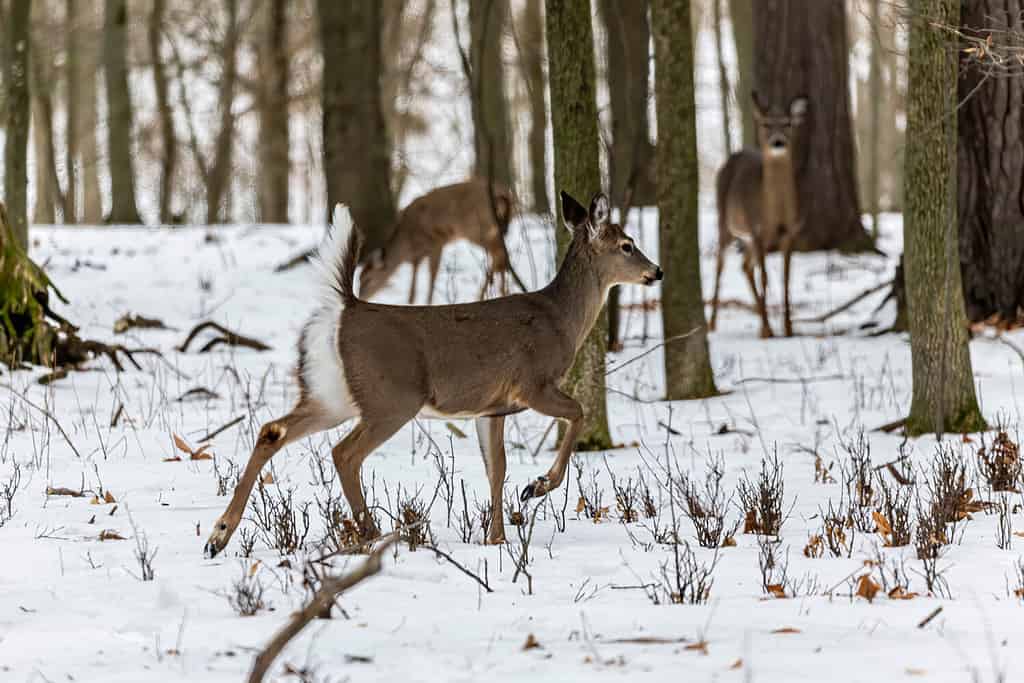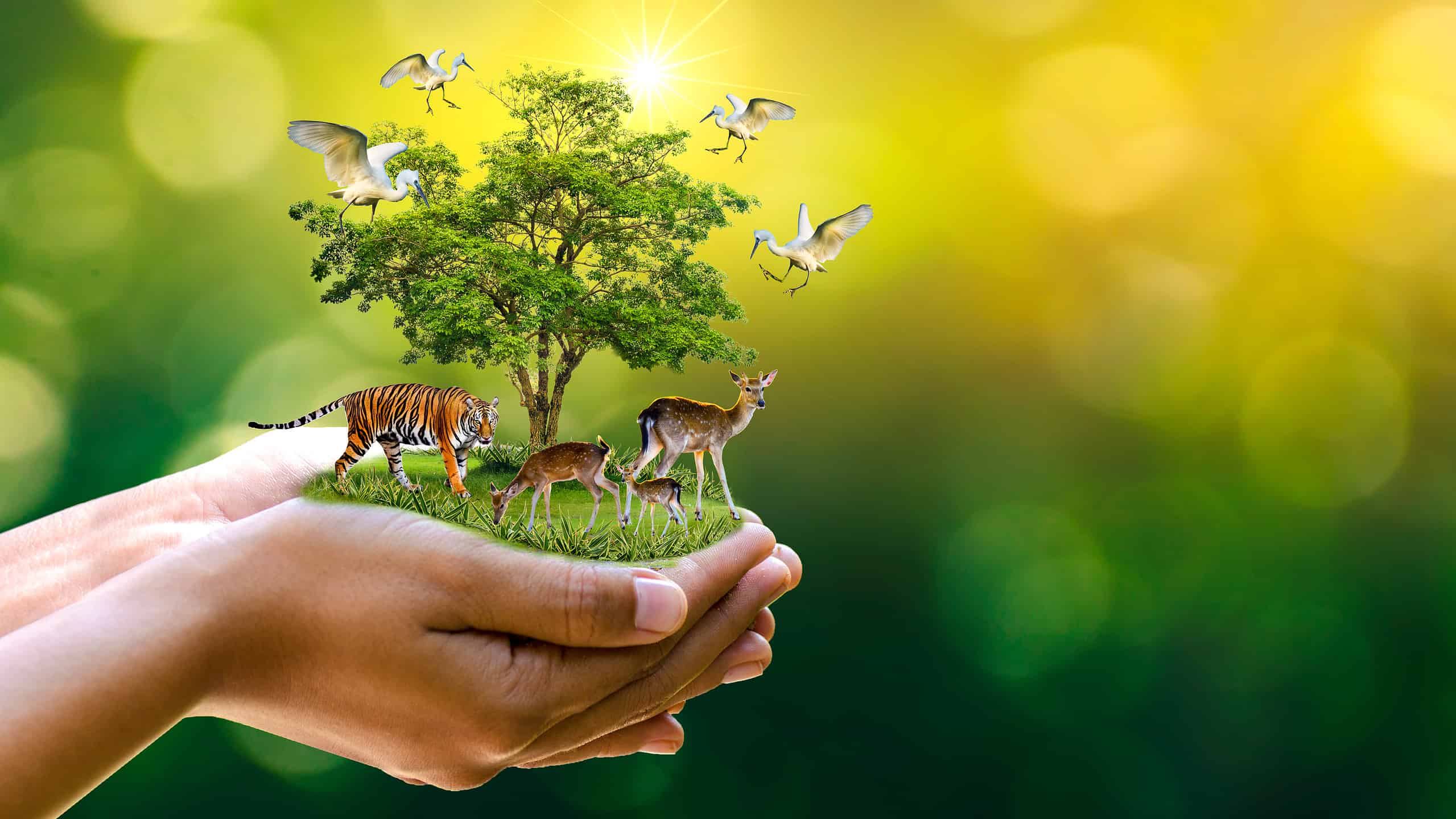When we see animals in the wild, it’s natural to want to see them up close. We want to connect with them, give them some food, and be their friend. This is especially true if it is a rare animal. Even more true if they’re cute! But one of the best things you can do to help take care of our world is to stop feeding wildlife.
However, aside from hunting such animals, feeding them (even natural food from their habitat) is among the worst things you can do for them! There is a reason why national and state parks, wildlife reserves, zoos, and all other natural preserves warn against feeding the animals. It is for their benefit as well as your safety.
General Rules for Wildlife and Food

Every animal is happier and healthier when they find and eat their own food.
©LauraBerlin/Shutterstock.com
Depending on where you go and what animals you visit, the rules for interacting with animals and wildlife will vary. If you’re ever in doubt about how to behave around animals and their food, the best advice is to not do anything. Keep wildlife wild. Most of the problems wild animals are facing these days stem from the actions of humans, even when they are trying to help. Even actions like feeding the ducks at the pond can have detrimental impacts on the health and behavior of migratory animals.
It is always a good idea to keep your distance from wildlife and let them find and eat their own food. No cute picture is worth harming the natural balance of wild areas. Stop feeding wildlife.
#1: Human Food is Bad for Their Health

Squirrels have become notoriously common at campsites. They know where to find human food.
©J Curtis/Shutterstock.com
Processed foods are full of chemicals and substances that are terrible for our bodies. They are even worse for native wildlife. Their bodies did not evolve to digest some of the foods we eat. Their digestive tracts are specifically designed to break down the foods in their habitat. This includes herbivores and carnivores. It is impossible for you to know how the food you are feeding certain animals will affect their bodies.
There are some examples of wildlife feeding that have already gained some attention to sop. Feeding bread to ducks fills them with empty calories so they don’t have room for healthy food. Throwing rice at weddings has killed doves and pigeons. Giving fast food to seagulls at the beach has poisoned their hatchlings.
However, this extends to fruits and vegetables grown for human consumption. You might think that such foods would be good for wildlife, but you’d be wrong. Humans have selectively bred certain crops for their taste and nutrition content. This has created larger and tastier food. In the last few decades, science has allowed us to kick this process into overdrive. As a result, the food and vegetables we eat today have significantly more sugar than their predecessors did just a hundred years ago.
This has become such a problem, in fact, that some zoos have stopped feeding their animals some fruits and vegetables because the animals became addicted to them and wouldn’t eat anything else! These fruits cause tooth decay and other health problems. Some animals even got sick because they weren’t getting the nutrients their bodies needed. It took a lot of work in some cases to return these animals to a pellet-only diet.
Feeding our fruits and vegetables to wild animals can wreak havoc on their bodies. If they get it too often, they might also get addicted to the high sugar content and refuse to eat their natural foods. This is bad for them, and bad for their environment.
#2: Eating Human Food is Bad for Their Behavior

A moose can, and will, kill you if you try to feed it.
©ArtBBNV/Shutterstock.com
When animals begin to rely on human food, they lose important skills they need to survive. Naturally, if they can choose between something easy and tasty from a human, or go on a dangerous or difficult hunt, they will choose the former. While you might think this is a good thing since it brings interesting wildlife close to observation areas more often. It is severely impacting wildlife ecosystems.
For example, some seagull populations have stopped teaching their young how to fish and hunt for food entirely. Instead, they teach their hatchlings where to go to find humans and leftover fast food. Experiments showed that these young gulls no longer know how to hunt and fish at all, and when the fast food disappears, the gulls quickly starve to death.
Every ecosystem relies on the living things within them to maintain balance. If one species suddenly begins to eat human food, it throws the balance off, affecting everything else in the food chain.
#3: Feeding Wildlife is Dangerous

Bears have learned where to go in neighborhoods to find food.
©Guy J. Sagi/Shutterstock.com
Wild animals are wild. There is a plethora of videos online of foolish people getting too close to wild animals and paying a high price. No matter what you see in movies or television shows, every animal has the ability to hurt or kill you. Large animals like cats, moose, bison, and others can injure or kill you. Smaller animals can bite you and spread deadly diseases. If you are far away from medical help and an animal injures or bites you because you tried to feed it, it quickly becomes a life-threatening situation.
If there is a particular place where many humans have been feeding wild animals over a long period of time, the danger increases. Large predators will be attracted to areas where smaller, vulnerable animals congregate. If the smaller animals have become overweight and slow because of a diet consisting of human food, you can be sure there will be predators nearby more often.
#4: Feeding Wildlife Encourages Bad Habits

Stop feeding ducks bread at the pond.
©Elena_Alex_Ferns/Shutterstock.com
Once animals learn where to find easy food, they will begin to seek out more of it. Every year there are stories of bears who find their way into small towns, ransacking grocery stores or tearing through pantries.
Wild animals are smarter than you think. Bears particularly have learned how to open coolers, locked containers, and other secured areas in order to find tasty treats. They learn this behavior because at some point, humans allowed them to eat human food, and now they want more.
As these animals seek out human food, the chances of humans and dangerous animals crossing paths increase. This is dangerous for them and us.
#5: Wild Animals Don’t Need to be Fed
Wild animals don’t need your food. You might think they look skinny or hungry, but healthy animals know when and how much to teach of their natural diet. They have all the tools they need to find food that is good for them. They don’t need your help.
The addictive chemicals in our foods throw off their hunger sense. They will eat more than they should, making it harder for them to hunt or move. Some animals will even eat human food when offered to them because it is fun and easy, even when they are not hungry.
#6: Feeding Animals Spreads Disease

Too many animals in one place can make them sick.
©Karel Bock/Shutterstock.com
When you feed wildlife, it attracts more than just a single animal. Other wildlife will approach hoping for some as well. This unnatural congregation of animals increases the likelihood of diseases spreading. Large flocks of birds, rodents, and other animals in a small area are not natural. These animals require space to keep the casualties from diseases low.
By encouraging these animals to gather around you for food, diseases can transfer more often and more successfully. Also, the animals will continue to linger around the area long after you have left. This is especially true if it is in an area where many people have been feeding wildlife over time.
#7: Feeding Wildlife Pollutes the Environment

Fish are sensitive to small changes in their water. Human food is a big contributor to these changes.
©O partime photo/Shutterstock.com
You might think you are being responsible with the food you are giving wildlife, but the leftovers can still be harmful. And sometimes, despite your best intentions, cheeky animals can make off with food inside the original container.
Large amounts of food waste encourage insects and other parasites to gather around the area. The toxic chemicals in foods can pollute nests, water, and other plant life. Man-made food containers can kill smaller wildlife and pollute streams and ponds.
Now, keep in mind that feeding wildlife also includes leaving food out where wildlife can access it. This can be in your garbage bins, unlocked coolers while camping or food left on a table outside. Just because you’re not around when the animals eat your food, doesn’t mean you aren’t harming them. Take care to store and dispose of your food properly so the wildlife can stay wild.
Thank you for reading! Have some feedback for us? Contact the AZ Animals editorial team.








